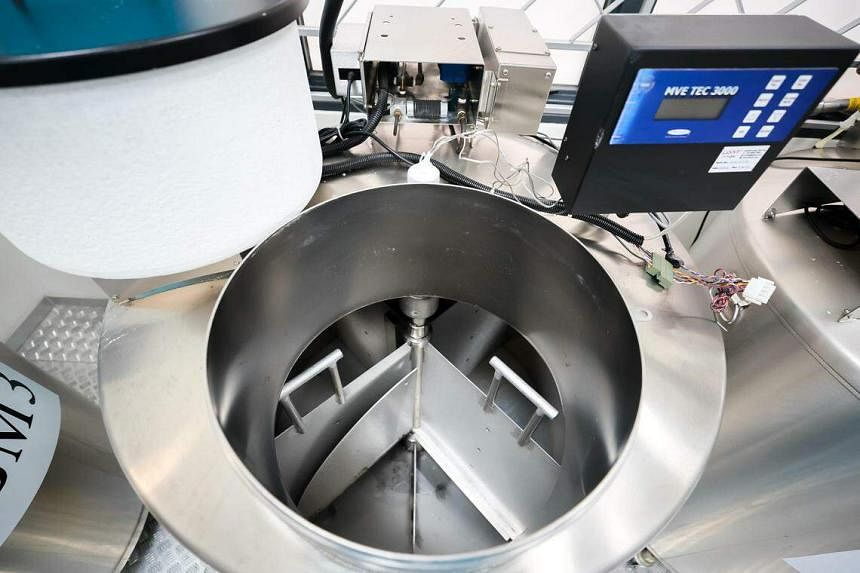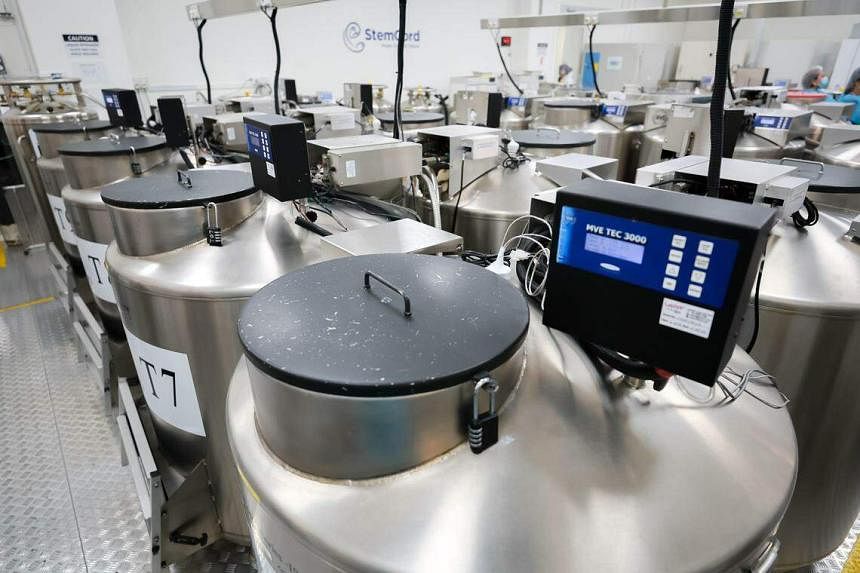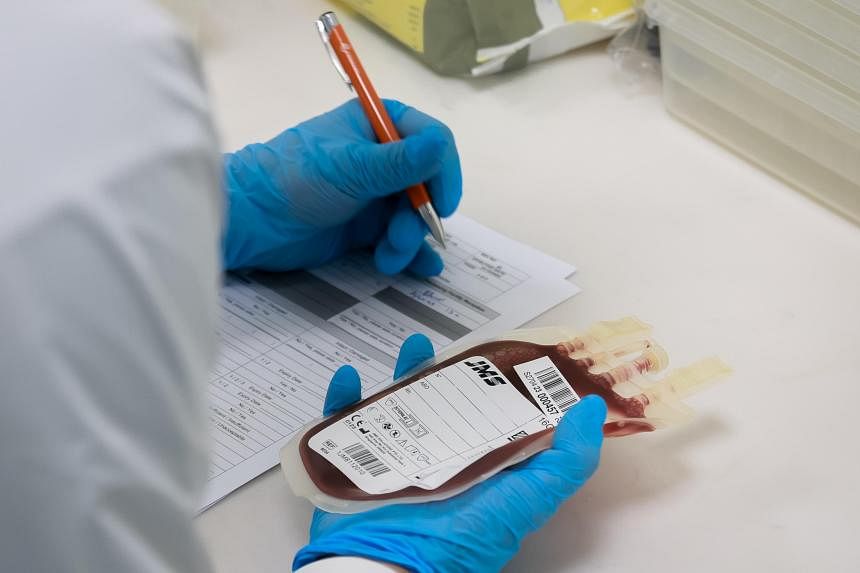SINGAPORE – In the wake of revelations that private cord blood banking company Cordlife had damaged over 2,000 cord blood units through exposure to suboptimal temperatures, there have been questions about how the firm’s storage and handling lapses could have occurred. The Ministry of Health’s (MOH) investigations are ongoing.
Cord blood is typically cryogenically stored for decades in stainless steel, vacuum-insulated cryogenic storage tanks, at temperatures of at least minus 150 deg C.
Upon request, StemCord, another private cord blood bank, hosted a tour of its facilities for The Straits Times to understand how it handles cord blood units. Cryoviva Singapore and Singapore Cord Blood Bank (SCBB), the Republic’s only public cord blood bank, replied via e-mail to ST’s same request with details about their processes.
ST looks at the safety measures that these banks have put in place to protect cord blood, from processing to storage.
Processing
1. Receiving of cord blood unit
After a baby is delivered, his umbilical cord is clamped and a needle is inserted into a vein in the umbilical cord to collect the blood. The collected cord blood is delivered to the laboratory, where a laboratory staff member will verify that it is from the correct client and that the cord blood bag is not damaged. Usually, one bag of cord blood is collected per child.
2. Machine processing
All collected cord blood is processed to maximise the recovery of stem cells. An automated and sterile cord blood processing system separates the cord blood into three components – plasma, red blood cells and white blood cells. The layer with concentrated white blood cells is kept for long-term storage. This process takes 30 to 40 minutes.
3. Pouring into cryogenic bags
The processed cord blood is poured into cryogenic bags, which typically have small segments that can be separated and used for testing purposes, so the full amount does not have to be retrieved unless needed.
4. Preparation for freezing
Once the cord blood unit is ready to be systematically frozen, a cryoprotectant is added into the cryogenic bags. The bags are sealed in a protective overwrap and placed into individual cassettes.
5. Controlled freezing
A controlled rate freezer is used to cool the cord blood units at 1 deg C per minute until it reaches an optimal temperature of minus 180 deg C. This takes about 90 minutes.
“If the cord blood unit is frozen too fast or too slow, that would damage the cells,” said StemCord’s laboratory director Eddie Yoh.
The frozen cord blood unit is moved into a quarantine tank via a cryogenic transfer box. It will remain there for up to two months, while awaiting test results to ensure that the cord blood units are free of bacteria, fungi and infectious diseases such as human immunodeficiency virus and syphilis. Once cleared, the units are moved to long-term storage.
Safety measures for storage
Cord blood banks are accredited by international bodies such as the Foundation for the Accreditation of Cellular Therapy (Fact) and Association for the Advancement of Blood and Biotherapies (AABB). Accredited banks have met rigorous standards in areas such as cord blood collection, processing, storage and banking.
For example, the NetCord-Fact International Standards for Cord Blood Collection, Banking, and Release for Administration states that storage systems for cord blood units need to have continuously active alarm systems, with audible and visible signals.
Acting on a complaint from a member of the public, MOH found that Cordlife’s temperature monitoring systems failed to send alerts when two of its tanks did not maintain optimal temperatures between February and June 2022.
The bank’s six-monthly preventive maintenance was also not carried out for two tanks in 2022. Further investigations are ongoing.
Dr Frances Verter, founder of United States non-profit organisation Parents Guide to Cord Blood Foundation, said: “It is shocking and puzzling how this accident happened because the storage tanks are supposed to have multiple layers of protection. It is hard to imagine how so many layers failed simultaneously.”
1. Nitrogen used to keep cryogenic tanks cool
Nitrogen is required to maintain cryogenic temperatures in storage tanks.
Cord blood units can either be submerged in liquid nitrogen or suspended in the vapour above a liquid nitrogen layer. All four cord blood banks in Singapore store units in the vapour phase.
Cryogenic tanks are usually connected to a huge storage tank of bulk liquid nitrogen, making it easy to resupply the liquid nitrogen at the bottom of the tank.
A Cryoviva spokesman said the liquid nitrogen is supplied through an automatic feeding system to ensure uninterrupted supply, and its levels are monitored by both manual and automated controllers.
StemCord’s Mr Yoh said the company’s supplier refills its liquid nitrogen cylinder almost daily to ensure sufficient supply for all its cryogenic tanks. StemCord also has backup liquid nitrogen cylinders.
2. Temperature-monitoring systems
All cord blood banks need to have temperature-monitoring systems that operate 24/7 and can raise the alarm if temperatures begin to rise.
Temperatures in cryogenic tanks are usually around minus 180 deg C. SCBB’s system triggers an alert when temperatures hit minus 170 deg C, while StemCord’s systems do the same at minus 160 deg C. Cryoviva did not say when its systems would sound an alarm.
StemCord uses an environmental-monitoring system that keeps track of all cryogenic tanks, fridges and freezers, as well as the room temperature in its laboratories. All monitoring data is kept permanently for future reference. The system will send alert messages via phone apps to all laboratory staff if issues crop up. All alarms have to be acknowledged and staff follow-up actions taken have to be documented in the cloud-based system.
Cryoviva’s alarm system is connected to both the facility operations and remotely to alert laboratory personnel in case of an incident occurring outside of normal laboratory operating hours.
SCBB’s system will sound an audio and visual alarm, and simultaneously send SMS notifications to its staff. If the alarm is left unattended, its senior management will be alerted.
Mr Yoh said there are two main reasons why a cryogenic tank would not be able to hold its cold temperatures. One is physical damage to the tank, causing it to lose its vacuum insulation. The other is insufficient liquid nitrogen in the tank.
“There shouldn’t be a sudden onset (of the tank’s ability to hold cold temperatures). For example, if there’s vacuum loss, we will be able to see telltale signs like perspiration on the exterior of the tanks,” said Mr Yoh.
The SCBB spokesman added: “For the temperature to go from minus 170 deg C (alarm point) to minus 150 deg C (critical point), it will take around three to five days if the lid of the storage tank is unopened. There is sufficient time to resolve the issue and preserve the unit.”
3. Backup measures

StemCord has two backup tanks if there is a need to transfer cord blood units from one cryogenic tank to another. When this has to be done, two laboratory technicians will be involved.
“The units will have to be moved batch by batch. This is because the temperatures of the backup tanks might rise to above minus 150 deg C when all the blood units are transferred at once, and this will become inefficiencies in long-term storage,” said Mr Yoh.
While cryogenic tanks do not depend on electricity to keep temperatures cold, their temperature-monitoring systems and plumbing systems for liquid nitrogen require power. StemCord has backup batteries for the systems that can last for up to two days in the event of a power shutdown.
4. Regular checks and audits

The cord blood banks do daily checks to ensure that the cryogenic tanks are within acceptable temperature ranges of below minus 150 deg C. Parameters such as the temperature and liquid nitrogen levels are documented in log sheets. StemCord and SCBB perform preventive maintenance for their equipment annually, while Cryoviva does it half-yearly.
A Cyroviva spokesman added that scheduled internal audits, management reviews and peer internal audits are conducted to ensure that all laboratory personnel follow the standard operating procedures.


